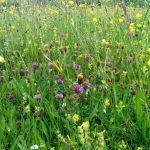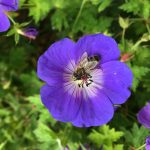Irish farmers growing strawberries, tomatoes, apples or oilseed rape know…
‘Farmland Guidelines: Actions to help Pollinators’ aims to get Ireland’s farmland buzzing again
The All-Ireland Pollinator Plan’s ‘Farmland Guidelines: Actions to help Pollinators’, which offers evidence-based actions farmers can take to help protect bees and enhance the livelihoods of farmers who rely on their invaluable pollination service was launched on September 20th at the Ploughing Championships by Minister of State at Department of Agriculture, Food and the Marine Andrew Doyle TD.
The Farmland Guidelines detail five ways to help make farmland more pollinator friendly:
1. Maintain native flowering hedgerows
2. Allow wildflowers to grow around the farm
3. Provide nesting places for wild bees.
4. Minimise artificial fertiliser use
5. Reduce pesticide inputs
Pollinators – our bees, bumblebees, hoverflies and other pollinating insects – have suffered huge declines in recent decades, with many now at risk of extinction. To address these declines and to try create an Ireland where pollinators can survive and thrive, the All-Ireland Pollinator Plan was launched in 2015. The All-Ireland Pollinator Plan is a shared plan with over 80 partner organisations, and has received support and funding from Bord Bia and the Heritage Council.
People often think the honeybee is solely responsible for all pollination, but in actual fact most is carried out by wild bees. In Ireland, we have 1 honeybee species, 20 bumblebee species and 77 solitary bees. ‘Unfortunately, Irish pollinators are in decline, with one third of our 97 wild bee species threatened with extinction,’ according to Dr Úna FitzPatrick, from the National Biodiversity Data Centre, who is responsible for coordinating the All-Ireland Pollinator Plan. ‘In order to produce the Farmland Guidelines, we worked with farming organisations and went through an extensive consultation phase with farmers to come up with straightforward, evidence-based actions to help our native bees.’
One of the main reasons for bee declines is hunger – there are simply not enough wildflowers in our landscapes today to provide enough food for bees. Bees rely entirely on nectar and pollen for food, which makes them our most important insect pollinators. A lack of safe nest sites, pesticides, and climate change also negatively impact bee survival.
“The All-Ireland Pollinator Plan is not just about conserving bees but is also about protecting the livelihood of farmers and growers who rely on their ‘free’ pollinator service, which allows consumers to buy Irish fruit and vegetables at an affordable price” Dr Fitzpatrick continued. “Not only do pollinators contribute to the Irish economy directly through crop pollination, they also contribute to our landscape and our ‘green’ image that is so vital to marketing our agricultural produce abroad. Some 78% of our wild plants benefit from insect pollination, so without healthy populations of wild bees, the Irish landscape would be a much different – less beautiful – place. This indirect value of pollinators to branding Irish products and to our agricultural export business is enormous.
”The new Farmland Guidelines have been developed in collaboration with Bord Bia and specifically Origin Green, the national sustainability programme for the Irish food and drink industry. Farmers who are certified to one of the Bord Bia Sustainable Quality Assurance schemes are members of the Origin Green programme. Each week, a team of over 100 Bord Bia Quality Assurance auditors undertake approximately 800 inspections on beef and dairy farms around Ireland. These inspections include compiling data on the sustainability of each farm. Over 160,000 assessments have been carried out to date, looking at responsible farm management measures including biodiversity, the use of water, energy, feed and fertiliser. Bord Bia has worked with the National Biodiversity Data Centre to incorporate elements of the All-Ireland Pollinator Plan into their new Sustainable Quality Assurance schemes. Actions identified to help pollinators will contribute towards a farmer’s sustainability criteria.
The Farmland Guidelines are available for download at www.pollinators.ie along with lots of tips and other resources on how to help.
Paddy Morris, EPA Catchments Unit







